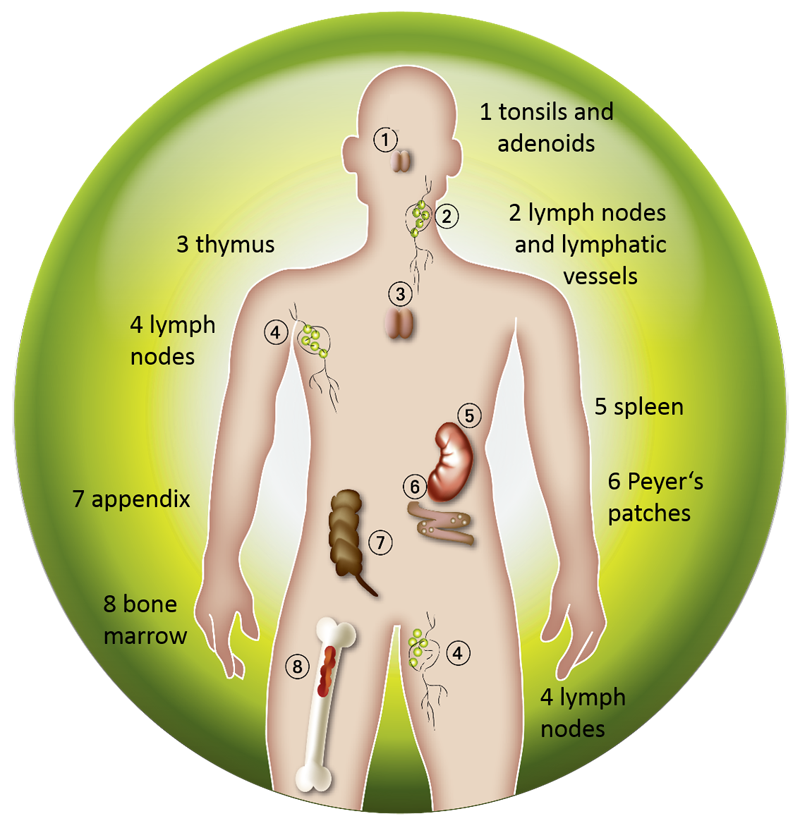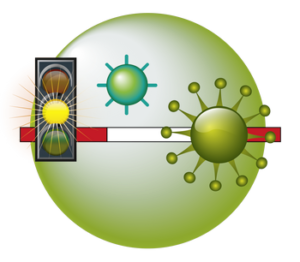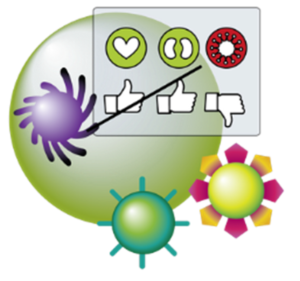When we talk about our “immune system” we are describing a wonderfully complex network of organs, cells and molecules that protect us from infection and disease.
When your immune system is working as it should, it recognizes abnormal cells, harmful “bugs” (infectious organisms that can cause disease) and destroys them. “Bugs” include anything that can cause an infection, such as bacteria, viruses or parasites. The immune system has also evolved to recognize and destroy cancer cells.
In this section you will find out how the immune system works, how it fights cancer and what you can do to keep your immune system healthy.
“Cells” are the basic building blocks of all animals, plants and microorganisms (bacteria, fungi etc.). Each organ in our body is made of cells, both the cells that define that organ (e.g. nerve cells in brain, muscle cells in heart) but also the cells that support organ function, like blood vessels and immune cells. The immune system protects us from infection, controls abnormal cells from growing and helps repair and rebuild damage that occurs in the body.
Our immune system is made up of physical barriers and several types of immune cell and organs. Physical barriers (e.g. the oily layer on top of our skin, the mucus lining of the nose, lungs, gut and stomach acid) are the most basic part of the immune system because they make it hard for bugs to get into our bodies.
The cells that contribute to the immune system are mostly derived from the bone marrow. Bone marrow is the soft material in the centre of large bones. It acts like a factory where “stem” cells produce an ongoing supply of blood cells:
- red blood cells to carry oxygen,
- platelets to repair leaky blood vessels and
- white blood cells.

White blood cells (or immune cells) fight infection and detect and eliminate abnormal cells from your body. There are many different types of white blood immune cells that have evolved to do different jobs.
For example some white blood immune cells are well adapted to fight bacterial infections (e.g. neutrophils) whereas other immune cells are better at fighting parasites like worms (e.g. eosinophils).
Immune cells are moved around the body in the bloodstream but also in a second network of vessels called the lymphatic system. The lymphatic system is a much more delicate set of pipes, but runs along the same pathways as blood vessels. Lymphatic vessels connect the immune system via a series of lymph glands (or nodes) and lymphatic organs. If white blood immune cells are soldiers then these lymph nodes and organs are like army barracks.
Lymph organs are shown in the diagram – and include the spleen, tonsils, lymph nodes, but immune cells also congregate in special areas in different organs (e.g. in Peyer’s patches in the gut). Together, these locations make up the lymphatic system. Immune cells constantly circulate through the body, coming to rest in these lymphatic organs where they can share information about infections and abnormal cells so that they are ready to fight an infection the next time they meet it. This is where cells of the immune system learn about vaccinations (e.g. diphtheria and tetanus) and the reason why you experience “swollen glands” in your neck when you suffer a cold.
How do the cells in the immune system work together?
 The immune system is like an army defending a castle. You can think of the immune system as an army defending a castle from invaders. The castle itself is a very important part of our immune defence; in this case “the castle” is our skin, and the mucus lining on the mouth, gut, nose and lungs.
The immune system is like an army defending a castle. You can think of the immune system as an army defending a castle from invaders. The castle itself is a very important part of our immune defence; in this case “the castle” is our skin, and the mucus lining on the mouth, gut, nose and lungs.
There are several types of white blood cells that have specialised in different ways to fight infection:
- Some cells act like foot soldiers or infantry; there are lots of them, they deploy rapidly so they are the first cells to arrive at an infection, but they don’t target or control the immune response. Some kinds of white cells that behave like this are so-called natural killer cells, neutrophils and granulocytes.
- The sergeants of the immune system are cells like monocytes and macrophages. There are fewer of these cells, but they play an important role in controlling the immune response at the battlefront. Some macrophages turn into cells called dendritic cells; these are like the spies of the immune system. They collect information about the infection or abnormal cells and show this to other immune cells to inform them of the threat.
- The most specialized cells of the immune system are lymphocytes. Lymphocytes are rare in the blood but important at the site of infection or in cancers, where they help specifically identify the target for the immune system to destroy. Lymphocytes use two different tools to identify target:
– B-lymphocytes are like archers. They produce antibodies, small proteins that float around the entire body that very specifically recognise a particular kind of infection or abnormal cell. When an antibody sticks to a target, it acts like a flag and attracts the attention of other immune cells that then destroy the abnormal cell or bacteria. Vaccines work by instructing B-lymphocytes to make antibodies against a particular bug or virus. These are so specific however, that even small changes in the bug or the abnormal cell mean that the antibody doesn’t work. For example this is why you need to take a new flu shot every year; as the influenza virus evolves and changes, so to must we evolve and change the vaccine to give us protection.
– T-lymphocytes are the second kind of lymphocyte, and come in two super special groups; commanders and commandos. T-lymphocytes don’t make antibodies, rather they make a similar kind of protein that sticks to the outside of the T-lymphocyte that is then used like a flashlight to examine each cell that the T-cell comes in contact with. Some T-lymphocytes (CD4) act as commanders of the immune system. They tell the immune system when to attack and when to retreat. People suffering HIV/AIDS lose these CD4 T lymphocytes and so their entire immune system is affected. People with HIV/AIDS suffer many cancers, and amazingly, if we can treat the HIV/AIDS with anti-viral drugs and restore the CD4-T-lymphocytes, then these people can see their cancers be cured. The other kind of T-lymphocytes (CD8) are like commandos; when they recognise a target cell they deploy a range of weapons to directly kill the target. It is these CD8-T-lymphocytes that appear to be the most important cells for killing cancers.
 Our immune systems have evolved over a long period of time, adapting in a never-ending arms-race against infections and abnormal cells. Part of this evolution has been in the way that immune cells recognise that something is wrong. The simpler cells of our immune system automatically recognise invading bacteria, but to detect viruses and cancer cells the most specialised cells of the immune system, the B and T lymphocytes have evolved ways to learn and recognise new targets.
Our immune systems have evolved over a long period of time, adapting in a never-ending arms-race against infections and abnormal cells. Part of this evolution has been in the way that immune cells recognise that something is wrong. The simpler cells of our immune system automatically recognise invading bacteria, but to detect viruses and cancer cells the most specialised cells of the immune system, the B and T lymphocytes have evolved ways to learn and recognise new targets.
Imagine this as a border sentry guard; “passport please”, asks the lymphocyte.
Each time a B or T-immune cell meets any other cell, the lymphocyte interrogates the identity of the cell by trying to match the proteins displayed on the outside of the cell. If the lymphocyte recognises the cell as “friend” then it is allowed to pass; if however the proteins on the surface of the cell are abnormal, then the lymphocyte identifies the cells as “foe”. The lymphocyte then raises the alarm, switching on its own attack systems but also sending off signals for help from the rest of the immune system.
By a slow, life-long process: When we are born we have had no exposure to bugs in the outside world; that is why it is so important to have everyone vaccinated against diseases to protect babies who have very weak immune systems. As we grow up, we experience more and more bugs, viruses and other challenges and our immune system learns and adapts with this. That is why we give vaccines in childhood because the immune system is learning, and can protect us for life from some diseases.
The cells of the immune system that do this learning are the lymphocytes. As we mentioned above, lymphocytes recognise other cells by interrogating proteins on the surface of cells. Other cells in our immune system (such as dendritic cells mentioned above) can teach lymphocytes who is friend and who is foe, by holding up pieces of these proteins for them to examine.
 Lymphocytes can then remember these identifications for our whole life, protecting us from infections and understanding who is friend and who is foe. This is why vaccines work. A vaccine is usually a weakened or dead form of a virus that won’t make you sick, but will teach your immune system how to recognise and fight that infection. If you are later infected by that particular virus, your immune system already knows how to fight it and will kill the virus before it can make you sick.
Lymphocytes can then remember these identifications for our whole life, protecting us from infections and understanding who is friend and who is foe. This is why vaccines work. A vaccine is usually a weakened or dead form of a virus that won’t make you sick, but will teach your immune system how to recognise and fight that infection. If you are later infected by that particular virus, your immune system already knows how to fight it and will kill the virus before it can make you sick.
This is also how lymphocytes can recognise cancer cells, or normal human cells infected with viruses. While these abnormal cells looks mostly like a normal human cell, the virus or the changes to proteins caused in cancer can make tiny changes to the proteins on the surface of the cell. The immune system is so sensitive that it can detect these tiny changes and therefore can recognise cells that are infected or cancerous.
Many of the more basic cells in the immune system just do their job without too much subtlety; run around, find bugs, kill them. Life is simple when you are a neutrophil.
The more sophisticated cells of the immune system like lymphocytes are under highly complex control, understandably so, because they can set off the alarm that sets a full-blown immune response into motion. After lymphocytes recognise another cell (“passport please”) their response to this recognition is influenced by dozens of further “handshakes”, a whole committee of checks and double-checks. These “checkpoints” have evolved to ensure that immune responses are always appropriate, and never occur without a good reason.
These checkpoints are pairs of proteins that line-up and face-off against each other when the surface of the lymphocyte and the surface of the cell it is interrogating are in contact. At the end of this arm-wrestle, a committee decision is made; either the lymphocyte turns on the alarm to set off an immune response, and tries to kill the cell in front of it, or the lymphocyte is satisfied that the other cell is not dangerous, allows it to pass, but most importantly allows all future identically identifying cells a “free pass”.
A few of the checkpoint proteins have become very important for the treatment of cancer (CTLA-4, PD-1 and PD-L1) and the remainder of them are being enthusiastically investigated to see if they too can be targeted to help people with cancer.
To work properly, your immune system needs to be able to tell the difference between ‘good’ cells (your own healthy cells) and ‘bad’ cells (bugs, human cells infected with viruses or cancer cells). If you have a weakened immune system, it will not recognise or fight the ‘bad’ cells as well as it should. This means that you are more likely to get infections or to develop cancer.
Examples of situations where your immune system is underactive include people suffering HIV/AIDS, people taking immune suppressing drugs to allow an organ transplant (e.g. a kidney transplant) or people taking long-term steroids to treat diseases e.g. chronic bronchitis
If your immune system becomes uncontrolled but overactive, it could start mistaking normal human cells for ‘bad’ cells and start attacking healthy cells. This can cause a number of problems, depending on which part of the body the immune system starts incorrectly attacking. For example, if the immune system recognises skin cells then one can develop dermatitis (inflammation of the skin). If cells in your gut become targets, then ulcerative colitis or Crohn’s disease (forms of inflammatory bowel disease) can occur. A number of other so-called “auto-immune” diseases can occur.
Allergic reactions are also caused by an overactive immune system but in this instance the immune system inappropriately recognises an external harmless substance (e.g. pollen, peanuts, and gluten) as being harmful and incorrectly activates the immune response.
Almost perfectly. We are generally oblivious to how well the immune system protects us from cancer. Lymphocytes recognise cells by the small fragments of protein displayed on their surface (“passport please”). Cancer cells are almost identical to normal human cells, but will display slightly different proteins on their surface from those on healthy cells. This is usually enough for the lymphocyte to recognise the affected cell and trigger the immune response which allows the immune system to destroy the evolving cancer cells. This is a highly efficient system, and the immune system finds and destroys almost all cancers as they develop. The effectiveness of the immune system in performing this surveillance and control of developing cancers is unfortunately well illustrated in people suffering immunodeficiency (see above).
Knowing that the immune system eliminates almost all cancers as they develop, we now understand that every cancer that actually grows to be big enough to be found by scans or symptoms has somehow evaded the immune system at some point in its evolution. There are many different ways that cancer cells learn to evade the immune system, but as the immune system evolves and learns, so too does each cancer.
One of the ways that cancer cells can block the effects of the immune system is to use some of the checkpoint proteins as ways to turn off immune cells. For example they can display one of the checkpoint proteins called PD-L1 on their surface. PD-L1 is mostly used by normal cells to signal that they are healthy and should not be destroyed by the immune system. In this case, the cancer cells are using a natural camouflage to trick the immune system into thinking that they are normal.
Although there are many products, diets, nostrums, supplements, practices, methods and concoctions that claim to “boost your immune system”, there is not much evidence that they help.
Boost your immune systemThere is evidence however that maintaining a healthy lifestyle is the best way to keep your immune system working well. You should therefore:
- eat a balanced diet that includes plenty of fruits, vegetables and whole grains, and is low in saturated fat
- exercise regularly
- maintain a healthy weight
- get plenty of sleep
- drink alcohol in moderation only
- do not smoke – smoking rapidly disables the immune system
- Stress can also make you more prone to illness, so it is important to look after your mental and emotional health too.
Additional resources include:
http://www.health.harvard.edu/staying-healthy/how-to-boost-your-immune-system
